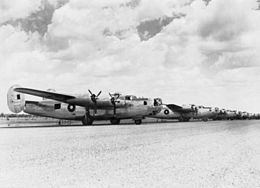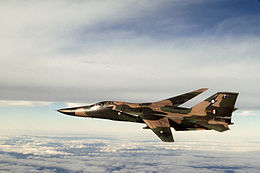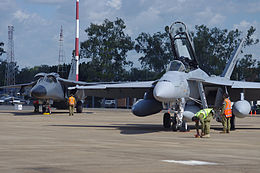- No. 82 Wing RAAF
-
No. 82 Wing RAAF 
No. 82 Wing's crestActive 1944–current Branch Royal Australian Air Force Role Precision strike; reconnaissance Part of Air Combat Group Headquarters RAAF Base Amberley Motto Find and Destroy Commanders Notable
commandersColin Hannah (1950–51) [1]
Charles Read (1957–60) [1]
Peter Raw (1965–66) [2]
Jake Newham (1971) [1]
Errol McCormack (1987–88) [1]
Geoff Shepherd (1995–98) [1]Aircraft flown Attack F/A-18F Super Hornet Reconnaissance Pilatus PC-9
IAI HeronNo. 82 Wing RAAF (2010)Components No. 82 Wing is the Royal Australian Air Force's strike and reconnaissance wing. It is headquartered at RAAF Base Amberley, Queensland, and operates the F/A-18F Super Hornet multirole fighter and Pilatus PC-9 forward air control aircraft. The wing was formed in August 1944, flying B-24 Liberator heavy bombers in the South West Pacific theatre of World War II. After the war it re-equipped with Avro Lincolns and, from 1953, English Electric Canberra jets. Both saw action in the Malayan Emergency; the Canberras were also deployed in the Vietnam War from 1967 to 1971. Between 1970 and 1973, as a stop-gap pending delivery of the long-delayed General Dynamics F-111C swing-wing bomber, the wing flew leased F-4E Phantoms. It then operated the F-111C for the next 37 years through numerous upgrades, augmented in the mid-1990s by ex-USAF G models, before retiring the type in 2010.
Contents
History
World War II
See also: B-24 Liberators in Australian serviceNo. 82 (Heavy Bomber) Wing—the RAAF's first—was formed at Ballarat, Victoria, on 25 August 1944.[3] Comprising Nos. 21 and 24 Squadrons, both equipped with B-24 Liberators, the wing became operational on 11 January 1945. By this time it was headquartered in the Northern Territory, and came under the control of the RAAF’s North Western Area Command (NWA). Based at Fenton Airfield, the wing's aircraft sank seven Japanese ships in the Dutch East Indies during March.[4] On 6 April, all of its available Liberators joined B-25 Mitchells of No. 79 Wing in an assault on a Japanese convoy that included the cruiser Isuzu. Anti-aircraft fire from the cruiser and other ships, as well as attacks by enemy fighters, resulted in the loss of two Liberators, and the crews' standard of aerial gunnery was criticised afterwards. Allied submarines sank the damaged Isuzu the following day.[5] Later that month, No. 23 Squadron, having recently converted to Liberators from Vultee Vengeances, was added to the wing's strength.[6]
The Liberators of No. 82 Wing played both a tactical and a strategic bombing role in the Borneo Campaign to free the Dutch East Indies from Japanese occupation, beginning with the lead-up to Operation Oboe One, the invasion of Tarakan on 1 May 1945. During the month a detachment relocated from Fenton to Morotai, attacking targets in Celebes and Balikpapan prior to Operation Oboe Six, the invasion of Labuan.[7][8] In June, while the final Allied offensive of the Borneo Campaign got under way as Operation Oboe Two, the Battle of Balikpapan, the remainder of No. 82 Wing transferred from NWA to the command of the Australian First Tactical Air Force in Morotai.[9] In the middle of the month the wing dropped 120 tons of bombs on Balikpapan's oil fields and surrounding areas, as well as coastal defence sites.[7] During July it bombed targets at Celebes and Borneo, losing five Liberators for the month. Just before the end of hostilities in the Pacific, the recently established garrison headquarters No. 11 Group unofficially directed the wing's operations.[10] Following the Japanese surrender in September 1945, No. 82 Wing's Liberators were converted to transports and used to repatriate RAAF personnel from the South West Pacific.[11]
Cold War and after
No. 82 Wing moved to its present location at RAAF Base Amberley, Queensland, in 1946.[12] No. 482 (Maintenance) Squadron was formed in May that year to be responsible for repair and upkeep of the wing's aircraft.[13] Its flying complement now included Nos. 12 (formerly of No. 85 Wing), 21, and 23 Squadrons, but these were renumbered Nos. 1, 2 and 6 Squadrons respectively in February 1948. By this time the wartime Liberators had been replaced by Avro Lincoln heavy bombers.[14][15] During 1949–50, some of the Lincolns were specially modified with advanced radar and other instrumentation to participate in Operation Cumulative, a joint program with the Royal Air Force gathering long-range navigation and bombing data for use in potential air campaigns against the Soviet Union. From 1952 to 1956, the Lincolns flew observation flights in connection with British atomic tests in Australia.[16]
In the 1950s and 60s, No. 82 Wing aircraft were heavily involved in overseas deployments. Between 1950 and 1958—for the first two years under the control of No. 90 (Composite) Wing—the Lincolns of No. 1 Squadron were tasked with the prime responsibility for the Commonwealth's bombing campaign against Communist insurgents during the Malayan Emergency.[17][18] In December 1953, No. 82 Wing took delivery of the RAAF's first jet bomber, the Canberra, which over the next five years re-equipped all three of the wing's squadrons.[19] The new bombers were acquired partly for their capacity to deliver nuclear weapons, an ordnance option the RAAF seriously investigated but never implemented.[20] Following the re-equipping of Nos. 2 and 6 Squadrons with the Canberra, a Lincoln Conversion Flight was formed in July 1955 under No. 82 Wing to provide training on the older bomber for crews preparing to deploy to Malaya for service with No. 1 Squadron; it disbanded in March 1956.[21] Canberras from No. 2 Squadron relieved the Lincolns of No. 1 Squadron in Malaya during 1958, and saw extensive action in the Vietnam War from 1967 to 1971. During the latter conflict they flew almost 12,000 sorties and delivered over 76,000 pounds of bombs, for the loss of two aircraft to enemy action.[22] Between 1970 and 1973, while awaiting the delayed delivery of General Dynamics F-111C swing-wing bombers, Nos. 1 and 6 Squadrons flew leased F-4E Phantoms, while No. 2 Squadron continued to operate the Canberra until disbanding in 1982.[19][23] Though not as sophisticated an aircraft as the F-111, the Phantom was a significant advance over the Canberra, and highly regarded by its RAAF crews.[24]
In June 1973 the wing accepted its first F-111Cs, which it continued to operate over the next 37 years through numerous upgrades, including the Pave Tack infra-red and laser-guided precision weapons targeting system, Harpoon anti-shipping missiles, and advanced digital avionics.[25][26] Roles within the wing were demarcated such that No. 1 Squadron was the lead strike unit, while No. 6 Squadron was primarily tasked with flying reconnaissance missions using specially modified RF-111Cs, and providing crew conversion training. In 1992 an order was placed to augment the F-111 force with 15 ex-USAF G models, operated by No. 6 Squadron.[26][27] As "the region's pre-eminent strike aircraft", the F-111 has been described as the most important acquisition in the RAAF's history.[28] The closest they came to being used in anger, however, was during the Australian-led INTERFET intervention into East Timor in September 1999. Both F-111 squadrons were deployed to RAAF Base Tindal, Northern Territory, to support the international forces, and remained there until December. From 20 September, when INTERFET began to arrive in East Timor, the aircraft were maintained at a high level of readiness to conduct reconnaissance flights or air strikes if the situation deteriorated. In the event, INTERFET did not encounter significant resistance, and F-111 operations were limited to reconnaissance by the RF-111Cs from 5 November through 9 December.[29]
No. 482 (Maintenance) Squadron merged with Amberley's No. 3 Aircraft Depot to form No. 501 Wing in December 1991, the squadron's disbandment taking pace in June the following year.[13] From 2001, Boeing Australia performed all F-111 maintenance under a contract to the Federal government.[30] In February 2002, No. 82 Wing came under the control of the newly established Air Combat Group (ACG), formed by merging Tactical Fighter Group and Strike Reconnaissance Group. The merger altered the wing's responsibilities, as it transferred lead-in training for the F-111s to No. 78 Wing at RAAF Base Williamtown, New South Wales, and put No. 82 Wing in charge of the strike capability of No. 81 Wing's F/A-18 Hornets, also based at Williamtown. No. 82 Wing's role was reiterated as "precision strike and reconnaissance"; the Forward Air Control Development Unit (FACDU), flying Pilatus PC-9s, was added to its strength.[31][32] FACDU was merged with the RAAF Special Tactics Project in July 2009 to form No. 4 Squadron.[33] In 2007, the Australian Government decided to retire all of the F-111s by 2010, and acquire 24 F/A-18F Super Hornets as an "interim" replacement, pending the arrival of the under-development F-35 Lightning II.[34][35] No. 82 Wing began re-equipping with the Super Hornet in 2010, and the last F-111s were retired on 3 December that year.[36][37] Also in 2010, the wing became home to No. 5 Flight, which is responsible for training personnel to operate the RAAF's two IAI Heron unmanned aerial vehicles based at Kandahar in Afghanistan.[38] In 2011 the RAAF acquired a third Heron, based in Australia and operated by No. 5 Flight for training purposes.[39]
Notes
- ^ a b c d e Air Marshals at Air Power Development Centre. Retrieved on 28 March 2011.
- ^ RAAF Historical Section, Bomber Units, p. 148
- ^ Nelmes, Tocumwal to Tarakan, p. 91
- ^ Odgers, Air War Against Japan, pp. 400–404
- ^ Odgers, Air War Against Japan, pp. 405–409
- ^ Nelmes, Tocumwal to Tarakan, pp. 107–109
- ^ a b Nelmes, Tocumwal to Tarakan, pp. 110–113
- ^ Odgers, Air War Against Japan, pp. 468
- ^ Odgers, Air War Against Japan, pp. 477–479
- ^ Odgers, Air War Against Japan, pp. 483–487
- ^ Odgers, Air War Against Japan, p. 495
- ^ Air Power Development Centre, "Superbase #1: RAAF Amberley Past to Future"
- ^ a b RAAF Historical Section, Maintenance Units, pp. 66–69
- ^ Avro Lincoln at RAAF Museum. Retrieved on 30 March 2011.
- ^ Nelmes, Tocumwal to Tarakan, p. 143
- ^ Stephens, Going Solo, pp. 445–449
- ^ Stephens, The Royal Australian Air Force, pp. 246–247
- ^ 1 Squadron RAAF at Australian War Memorial. Retrieved on 14 May 2011.
- ^ a b Canberra at RAAF Museum. Retrieved on 30 March 2011.
- ^ Stephens, Power Plus Attitude, pp. 108–109, 148–149
- ^ RAAF Historical Section, Training Units, pp. 158–159
- ^ Stephens, The Royal Australian Air Force, pp. 248, 271–273
- ^ No 2 Squadron at RAAF Museum. Retrieved on 17 March 2008.
- ^ Stephens, Going Solo, pp. 387–388
- ^ Stephens, The Royal Australian Air Force, p. 282
- ^ a b General Dynamics F-111 at RAAF Museum. Retrieved on 28 March 2011.
- ^ Eather, Flying Squadrons of the Australian Defence Force, p. 35
- ^ Stephens, Going Solo, pp. 393–394
- ^ Wilson, Warden to Tanager, pp. 32–34
- ^ Boeing Delivers Final Deeper Maintenance Program F-111 to Royal Australian Air Force at Boeing Australia. Retrieved on 20 May 2011.
- ^ "Air Combat group set to fly". Air Force News. September 2001. http://www.defence.gov.au/news/raafnews/editions/2001/4308/story06.htm. Retrieved on 28 March 2011.
- ^ Codey, Rebecca; Bradley, Christine (February 2002). "Set to fly". Air Force News. http://www.defence.gov.au/news/raafnews/editions/4402/story01.htm. Retrieved on 28 March 2011.
- ^ "Special Tactics people wanted". Air Force News. July 2009. http://www.defence.gov.au/news/raafnews/editions/4913/topstories/story5.htm. Retrieved on 20 March 2008.
- ^ "Super Hornet Acquisition Contract Signed." defence.gov.au. Retrieved on 3 December 2010.
- ^ "ALP to stick with Super Hornet buy." National via theage.com.au. Retrieved on 21 July 2010.
- ^ McPhedran, Ian. "F-111 – the RAAF's white elephant in the sky." Daily Telegraph, August 2009. Retrieved on 3 August 2009.
- ^ Binskin, Air Marshal Mark. "Pigs' Tales: Official F-111 Retirement Events". Boeing. Retrieved on 3 December 2010.
- ^ McLaughlin, Andrew (April 2010). "Nankeen. The RAAF enters the UAV era with Heron lease". Australian Aviation (Fyshwick: Phantom Media) (No. 270): p. 31. ISSN 08130876.
- ^ Smith, Skye (12 May 2011). "5FLT training down under". Air Force. http://digital.realviewtechnologies.com/default.aspx?xml=defencenews_airforce.xml&iid=48077&startpage=22&crd=0&searchKey=5flt. Retrieved on 14 May 2011.
References
- Air Power Development Centre (September 2008). "Superbase #1: RAAF Amberley Past to Future" (PDF). Pathfinder, Issue 97 (Royal Australian Air Force). http://airpower.airforce.gov.au/admin/productfiles/publication/materials/346/pf97_sept08.pdf.
- Eather, Steve (1995). Flying Squadrons of the Australian Defence Force. Weston Creek, Australian Capital Territory: Aerospace Publications. ISBN 1875671153.
- Nelmes, Michael V. (1994). Tocumwal to Tarakan. Australians and the Consolidated B-24 Liberator. Belconnen, Australian Capital Territory: Banner Books. ISBN 1875593047.
- Odgers, George (1968) [1957]. Australia in the War of 1939–1945: Series Three (Air) Volume II – Air War Against Japan 1943–45. Canberra: Australian War Memorial. OCLC 246580191. http://www.awm.gov.au/histories/second_world_war/volume.asp?levelID=67913.
- RAAF Historical Section (1995). Units of the Royal Australian Air Force: A Concise History. Volume 3: Bomber Units. Canberra: Australian Government Publishing Service. ISBN 0644427957.
- RAAF Historical Section (1995). Units of the Royal Australian Air Force: A Concise History. Volume 7: Maintenance Units. Canberra: Australian Government Publishing Service. ISBN 0644427981.
- RAAF Historical Section (1995). Units of the Royal Australian Air Force: A Concise History. Volume 8: Training Units. Canberra: Australian Government Publishing Service. ISBN 0644428007.
- Stephens, Alan (1992). Power Plus Attitude: Ideas, Strategy and Doctrine in the Royal Australian Air Force 1921–1991. Canberra: Australian Government Publishing Service. ISBN 0195555414. http://airpower.airforce.gov.au/Publications/List/38/Historical-Titles.aspx?page=3.
- Stephens, Alan (1995). Going Solo: The Royal Australian Air Force 1946–1971. Canberra: Australian Government Publishing Service. ISBN 0644428031.
- Stephens, Alan (2006) [2001]. The Royal Australian Air Force: A History. London: Oxford University Press. ISBN 0195555414.
- Wilson, David (2003). Warden to Tanager: RAAF Operations in East Timor. Maryborough, Queensland: Banner Books. ISBN 1875593268.
External links
- No. 82 Wing Headquarters. "Operations Record Book". RAAF Unit History (Form A50). National Archives of Australia. http://recordsearch.naa.gov.au/scripts/Imagine.asp?B=1359988&I=1&SE=1.
Categories:- RAAF wings
- Military units and formations established in 1944
Wikimedia Foundation. 2010.




